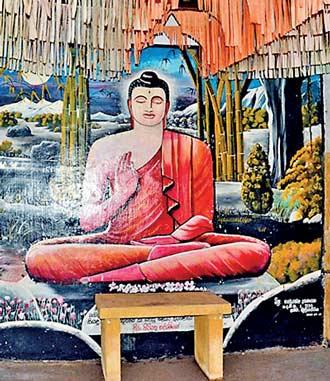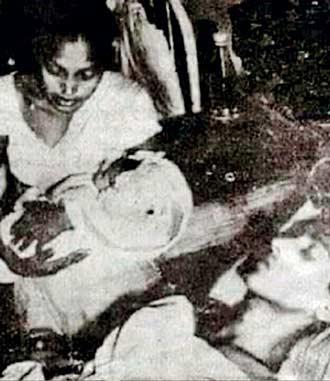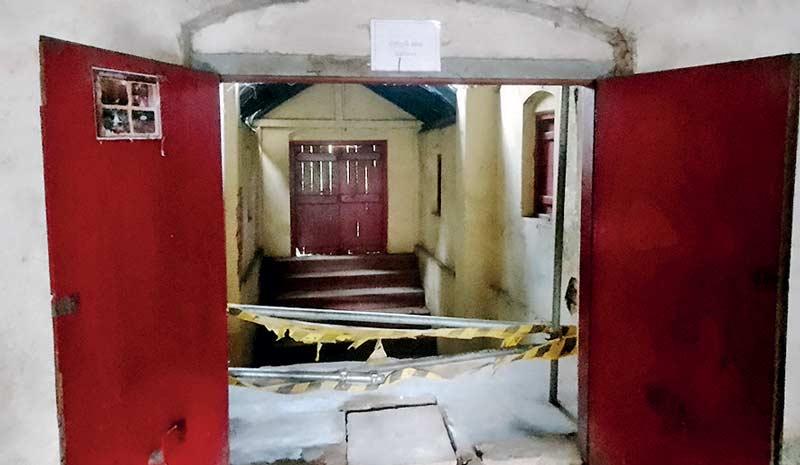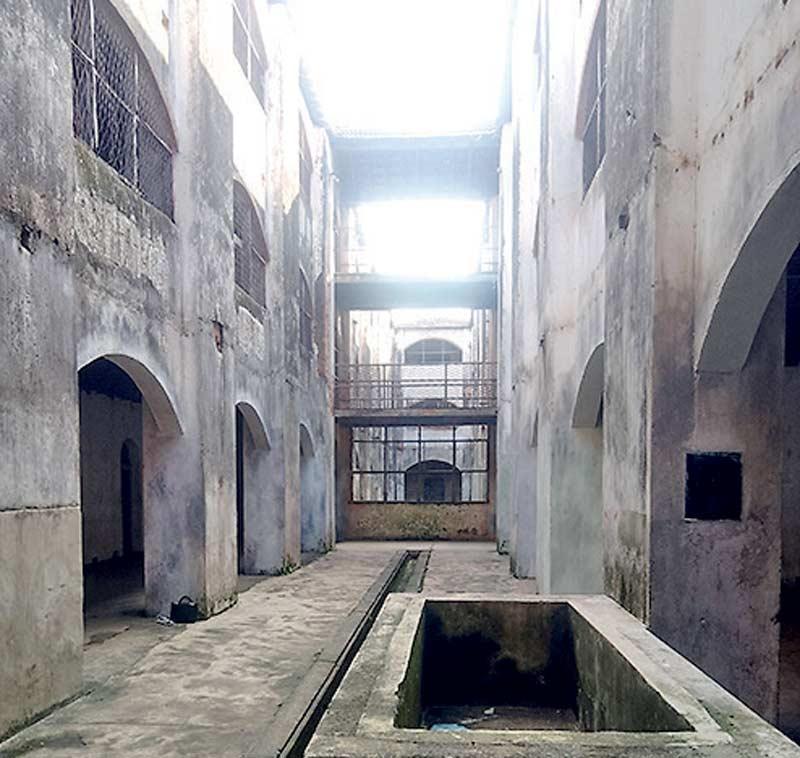Bogambara: A sinister Bastille shared by Sardiel and Dr. Colvin R. de Silva
 The Bogambara prison complex has stood the test of time, convicting legendary characters and individuals who were accused of wrongdoing
The Bogambara prison complex has stood the test of time, convicting legendary characters and individuals who were accused of wrongdoing
By Shantha Chandrasiri

A painting of Buddha near the gallows |

Ranmanika visiting an ailing Siripala in prison |
The name Bogambara evokes historical events, but it became best known for the prison by that name. Back in the 19th century, Ehelepola Kumarihami was drowned by royal edict in the Bogambara lake. The prison, constructed after filling in the lake, is now closed, with the Dumbara prison at Pallekeke taking its place. After functioning for 138 years, Bogambara prison was closed on Jan. 01, 2014, and is now open to public view.
The decision to construct a prison at the site of the lake was taken by British colonial authorities in 1832, and the prison was declared open in 1872. The prison was designed to reflect the shape of Queen Victoria’s crown.
Prisoners put to work
It was decided to build a prison here because the existing Welikada prison was considered insufficient to hold the increasing numbers of prisoners. Building a prison here on the site of a lake could not have been an easy task. Ninety two prisoners as several work gangs were involved in the construction work. The prison has a floor area of 91,000 square feet and consists of 328 cells arranged on three storeys, as well as a 9000 sq. ft. prison hospital. This is said to be the longest building in Asia built on a single foundation. It can hold 408 prisoners in 328 cells.
The prison, situated on thirteen acres of land, is surrounded by a Bastille-type 102-foot high wall. This prison is interesting from an architectural point of view and cost Rs. 450,000 back in the 19th century. It was constructed by the Public Works Department under the supervision of police and prisons commissioner N. R. Sanders.
Bogambara is the second largest prison in the country after Welikada. These two were the only prisons where the death penalty was carried out. Three people could be hanged simultaneously at Bogambara, the only prison here with that facility. The D Block (the gallows) was reserved for those facing the death penalty and those waiting after appeals. The execution block with the hangman’s noose was on the ground floor. Those prisoners serving ordinary prison terms as well as appeal prisoners as well as extended death sentences shared the other ground floor areas.
Death row conditions
Those facing the death penalty were moved gradually closer to the place of execution via a series of seven adjoining cells. They were given the meals of their choice as well as the opportunity to meet family members. But there is no record of anyone on death row or the gallows having meals or meeting anyone the day before execution.
The convict was facing the direction of the Temple of the Tooth as the noose was tightened around his neck. There is a large Buddha image on an adjacent wall. It was painted by a death row prisoner from Kuliyapitiya awaiting after an appeal. Only number his number (7233) is known, not his name.
The picture of the Buddha at the entrance to the first floor had been drawn by a condemned prisoner who had appealed against the death sentence. He was a resident of Kuliyapitiya area. Only his number (7233) is known, not his name.
From the opening of the Bogambara prison in 1876 to its closure in 1975, 524 convicts were hanged. Any execution had not been performed after 1975. The last two prisoners to be executed were convicts of the Thismada murder that sent a shock wave across the country – W. G. Richard Jayawardene and T. M. Jayawardene. They were been hanged on November 21 and 22 , 1975. The death penalty was suspended after this date.
Sardiel, Maru Sira and Colvin
Utuwankande Saradiel and Maru Sira, legendary characters in their time,were executed at Bogambara. Dr. Colvin R. de Silva, Philip Gunawardhane and William de Silva are among the famous who were imprisoned at Bogambara.
There is a folklore associated with the prison, including several folk poems.
The decision to close down the prison was taken in 2014 due to congestion and Kandy’s municipal construction plans. The new prison at Pallekele is called the Dumbara prison. The Urban Development Authority allows the public to visit the former prison complex. It draws large crowds, but anyone entering this building which resembles a sinister Bastille should feel somewhat nervous. If that is the case, what can one say about those who stepped in here facing prison terms or the death penalty?

The place that used to be the gallows

Interior of the prison complex






